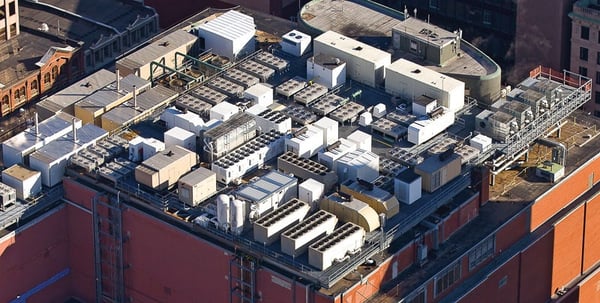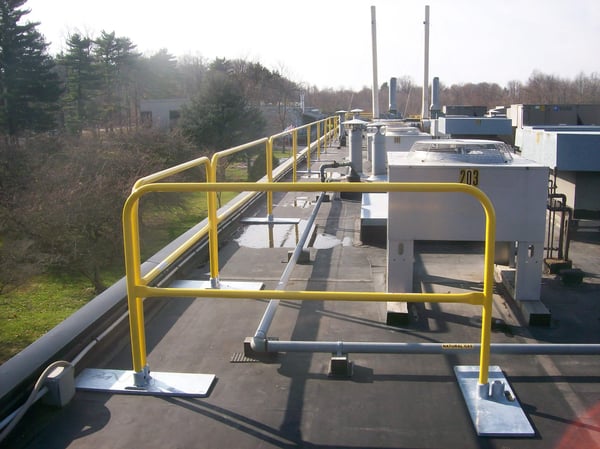Roof Fall Protection For Data Centers
Today’s digital economy is driven by data centers, and in many areas of the country with large pockets of data center activity, new facilities aren’t going online fast enough to keep up with demand. The data center boom has made the transfer of information more efficient, but it is also exposing maintenance personnel and contractors to new fall hazards that require a creative approach to remediation. Here’s why….
From ground level, the typical data center doesn’t look much different from other commercial buildings, but if you look at the same structure from overhead, you’ll notice an extensive array of HVAC equipment to prevent the servers from overheating. Rooftop HVAC is critical to the function of any data center, and maintaining system up time requires frequent preventative maintenance, inspection, and repair. All of this activity creates regular rooftop visits which exposes personnel to fall hazards.

As a rule of thumb, larger roofs requiring complete perimeter fall protection are ideal candidates for horizontal lifelines. There is always a tipping point where lifelines become more cost-effective than guardrail, and yet, the roof shown above is protected by guardrail. If a lifeline is the most cost-effective solution, why is this roof protected with guardrail?
Earlier, we mentioned a shortage of available buildings in the east and west coast data center hubs. In northern Virginia–an area sometimes referenced as “data center alley”, acquiring a new construction building permits takes years, which in turn forces many companies to lease space. Leasing instead of owning means asking permission to modify the roof to install a permanent roof lifeline system. We’ve come a long way in the fall protection industry, and gone are the days when installing a lifeline meant cutting large holes to attach rigid post anchors. Nowadays, we can often use toggle bolts or mechanical anchors to secure tip over posts. That said, if you are leasing, the property owner may not allow even the minimal penetrations that come with a tip over post lifeline installation.
Assuming you are authorized to make permanent roof modifications to the roof, the nature of the equipment inside the building is still a concern. Perimeter lifelines constructed with tip over posts DO minimize rooftop penetrations, but even with proper flashing, some clients worry about leaks. Roof leaks on a typical commercial building can cause anything nuisance drips to some pretty extensive damage. Even a minor leak in a data center setting can cause crippling system downtime. For all of these reasons, and despite the larger roof foot prints, non-penetrating guardrail is almost always the solution of choice for data center applications.
There are a number of different guardrail options on today’s market, so how do you choose the best available option? One of the best ways to size up guardrail is to focus on the most inconspicuous part of the system–the base plate design. Every manufacturer offers a receiver-style base plate that negates the need to penetrate the roof, but base plates can range anywhere from a low of 57 pounds (DFP base plates) to over 100 pounds. Heavier base plates are more expensive to ship and put more load on the roof. The other consideration when comparing guardrail systems is whether you can purchase manufacturer direct or if the product is sold through distribution. We manufacture every section of guardrail–and every base plate–in our Cleveland, Ohio facility and sell direct pass the savings along to our clients.

Protecting your workers while working on your data center’s roof can seem like a daunting task, but we have a cost-effective solution that will protect your personnel–and your servers–without busting your budget. To learn more, or to discuss the specifics of your roof guardrail application, contact Diversified Fall Protection for further assistance.
Schedule an assessment with Diversified Fall Protection
Contact Us to request a fall safety review

b-1.jpg?width=1368&height=1340&name=Rail%20(175)b-1.jpg)

